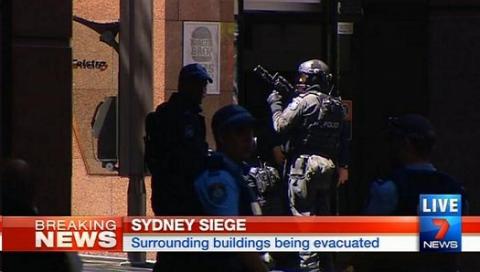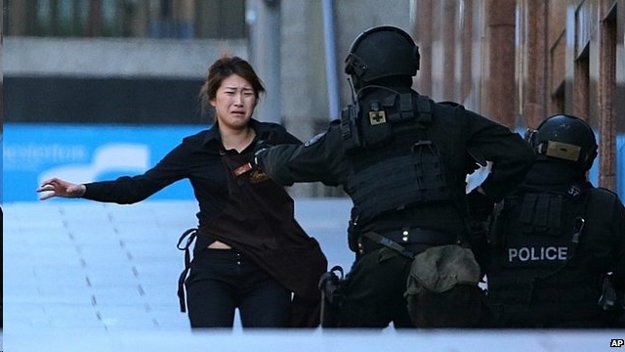Covering the Sidney Siege: Media Should Think First, Broadcast Later

From Firstpost.com:
The unfolding Sydney hostage crisis had all the trappings of live television drama.
There was the Breaking News tag under the Sydney Siege Headline. The world LIVE at the corner of the screen. The footage of a soldier with a gun pointed, a young woman running down the street, the window of Lindt Café wishing the world Merry Christmas, a man at the window with his hands raised, his face blurred.
It’s only the little caption on the upper right-hand corner that indicates that what we are seeing is not what is actually happening. Recorded earlier it says almost unobtrusively.
What is likely going on? We just don’t know, says the CNN anchor. A security expert Michael Roach replies “The police want to manage the situation and not have it be controlled by the media.”
24x7 television has led us to believe we can get a ringside view into any crisis happening around the world. And certainly a café in the heart of Sydney is not some remote corner of the world. Ordinary citizens have reinforced that idea with their mobile phones rushing in to bear witness even before the television camera can reach the spot. The television stations obviously have live footage but are choosing not to air it.
Media should have been careful about its coverage of the Sydney hostage situation. That makes it very much not 2008 anymore.
The 2008 hostage crisis at the Taj in Mumbai that went on for a grueling 67 hours clearly showed us how the networks’ haste to deliver breaking news and the public’s appetite to devour breaking news could create a vicious circle with deadly consequences.
On the second day of the Mumbai attacks, the News Broadcasters Association issued an advisory urging “self-restraint and self-regulation” to ensure that the coverage did not “interfere in the operations of security agencies or impede the terrorists being brought to justice or endanger the lives of persons who are in the midst of the terror attacks.” While the NBA asked the media to take the advisory with “utmost seriousness,” an essay analyzing the coverage writes that in the “rat-race” to be the first to break news and bump up ratings, it pretty much fell on “deaf ears”.
Television showed footage of commandos rappelling down to the roof of the Jewish centre where the terrorists were holed up. One television station aired a telephone conversation with one of the gunmen. Television reported commando operations and positions and the locations of hostages inside the hotel apparently unaware or not thinking that the same feed was being watched by the handlers of the terrorists.

The coverage became quickly a noxious combination of both too little and too much. While on one hand, there was clearly too little thought being given to the impact of what was being shown, there was also too much of jumping to conclusions before the facts warranted it.
Television channels played martial filmi music between the updates and were quick to blame Pakistan for the attacks. Whether Pakistan was to blame or not is not the issue. The issue is whether in the middle of a hostage crisis, the media should not fan tensions and play judge, jury and executioner.
There was some element of that happening in Sydney as well with channels like CNN speculating about whether this is an Islamic State attack. While the experts kept saying it’s too early to tell and there is no proof either way, the hosts kept pressing whether indeed this does not fit the modus operandi of Islamic State. Perhaps these are frustrated Australian IS sympathizers, unable to go to the Middle East, who have taken over the Lindt café? Could he be someone trained over the internet by ISIS, an anchor asks. It might well be true but when all we have currently is the image of a black flag with some Arabic writing, it’s just pure speculation which is irresponsible. But 24x7 television must fill air time.
"The [media] beast has got to be constantly fed. The information flow from government sources was terrible," Rajdeep Sardesai, then editor-in-chief of CNN-IBN told the Christian Science Monitor after the media was lambasted for its telecast-first-think-later coverage. Afterwards Barkha Dutt conceded to the Christian Science Monitor that there were lessons to be learned. “If there is even a shadow of doubt of security being compromised, the industry should be willing to delay telecast,” she said.
The National Broadcaster Association put out a new set of rules including a ban on live contact between hostages or attackers.
India, fortunately, has not had to face a hostage attack on the scale of 26/11 since then to see whether these rules and guidelines hold up when push comes to shove and whether the entire industry abides by them or the rat race for TRP begins again. The key will be to see if all the networks take a common pledge of restraint or cannot resist the temptation of oneupmanship.
After the Westgate mall terrorist attacks, the Media Council in Kenya commended the media for professionalism, though it noted a few Code of Conduct breaches occurred for example using some pictures and names without taking into account whether they might harm the people concerned.
What makes it tougher now is that social media is the Wild Wild West of rumor, innuendo, images including doctored images purporting to be breaking news. And any of that can go viral. That makes it harder for the broadcast media to hold back instead of rationalizing it as an excuse to jump on the bandwagon. The public always wants something new and tires of the same images being shown on a loop on their television screens but while the beast must be fed, in the middle of hostage crisis, the media has to remember a basic mantra.
Their job is to report but sometimes the need to save lives needs to trump LIVE.
From Firstpost.com




























































































































































































































































































































